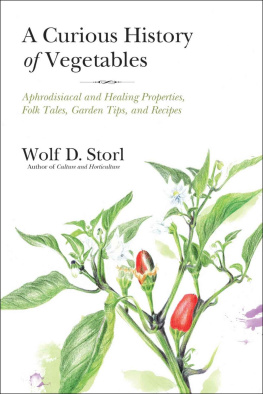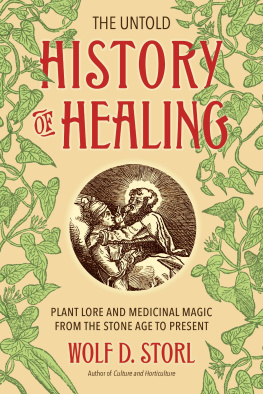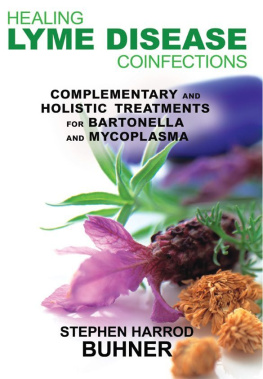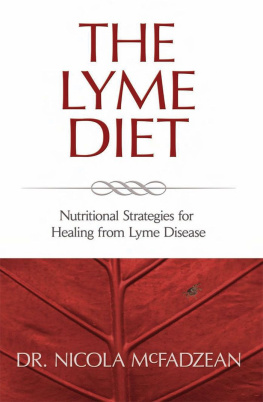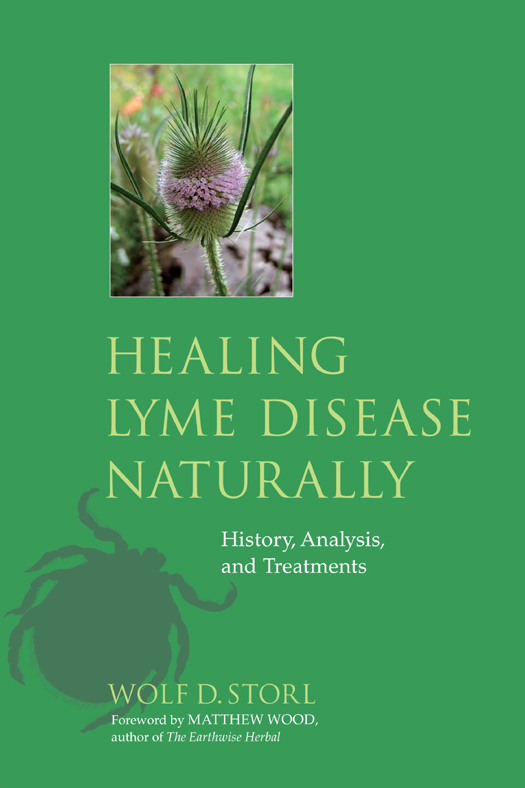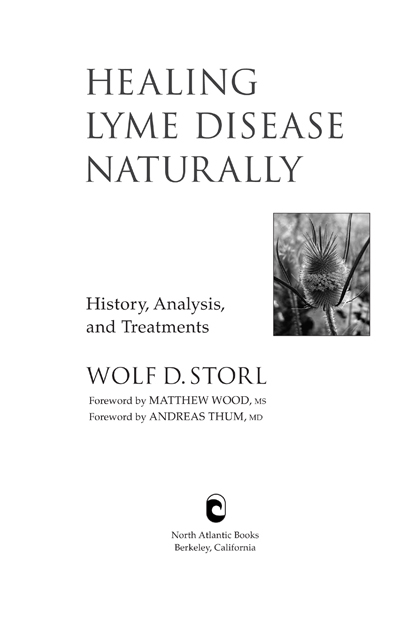Copyright 2010 by Wolf D. Storl. All rights reserved. No portion of this book, except for brief review, may be reproduced, stored in a retrieval system, or transmitted in any form or by any meanselectronic, mechanical, photocopying, recording, or otherwisewithout the written permission of the publisher. For information contact North Atlantic Books.
Published by
North Atlantic Books
P.O. Box 12327
Berkeley, California 94712
Cover photo and all photos for color
insert Frank Brunke
Cover art by Brad Greene
Cover design by Brad Greene
First published in 2007 as Borreliose natrlich heilen by
AT Verlag, Baden and Mnchen
Healing Lyme Disease Naturally: History, Analysis, and Treatments is sponsored by the Society for the Study of Native Arts and Sciences, a nonprofit educational corporation whose goals are to develop an educational and cross-cultural perspective linking various scientific, social, and artistic fields; to nurture a holistic view of arts, sciences, humanities, and healing; and to publish and distribute literature on the relationship of mind, body, and nature.
North Atlantic Books publications are available through most bookstores. For further information, visit our website at www.northatlanticbooks.com or call 800-733-3000.
MEDICAL DISCLAIMER: The following information is intended for general information purposes only. Individuals should always see their health care provider before administering any suggestions made in this book. Any application of the material set forth in the following pages is at the readers discretion and is his or her sole responsibility.
Library of Congress Cataloging-in-Publication Data
Storl, Wolf-Dieter.
Healing Lyme disease naturally : history, analysis, and treatments /
Wolf D. Storl; foreword by Matthew Wood; foreword by Andreas Thum.
p.; cm.
Includes bibliographical references.
eISBN: 978-1-58394-437-0
1. Lyme diseaseAlternative treatment. 2. Naturopathy. I. Title.
[DNLM: 1. Lyme Diseasetherapy. 2. Dipsacaceae. 3. Lyme Disease
physiopathology. 4. Naturopathy. 5. Phytotherapy. WC 406 S885h 2010]
RC155.5.S76 2010
616.9246dc22
2010005807
v3.1
CONTENTS
FOREWORD
Matthew Wood, MS (Herbal Medicine)
Registered Herbalist (American Herbalists Guild)
T he book you hold in your hands is exciting. Its principle purpose is to discuss the so-called plague of the outdoorsman, Lyme disease, and to reveal a reliable, safe, common, oft-proven remedy for most cases of Lyme disease, the common roadside weed, teasel (Dipsacus sylvestris). Wolf-Dieter Storls fast-paced journey through the material reads like an adventure storywhich it isof the authors own migration from sickness to health and of his education in Lyme disease. The most modern research is brought to bear on the subject, including evidence showing that antibiotic treatment is a failure, except in the first few weeks after infection. The nature of the Lyme spirochete, Borrelia burgdorfi, is discussed at length. But this book is much more. The author is a medical anthropologist and ethnobotanist. Instead of merely reviewing the scientific literature, he questions it, and asks spiritual and mystical questions about soul, spirit, healing, shamanism, and the nature of modern biomedicine. Dr. Storl is also familiar with the basic tenets of European naturopathy, which values sunlight, the outdoors, air, water, freshwater and saltwater bathing, the earth, and good food. Then he is an experienced herbalist with knowledge, not only of the modern phytotherapeutic tradition of scientific herbalism, but of traditional central European plant and woods lore.
When a book is written that is profound and searching, the author comes across all sorts of helpers along the way. A deep book even awakens ones ancestors. Dr. Storls maternal ancestors, for many generations, were weavers. In a touching account, his grandfather opens a tattered old box and reveals the core instrument of his profession, the ancient (still used) Fullers teasel (Dipsacus fullonum), a hybrid of the wild teasel, used to card wool.
This book is important because it fearlessly crosses the lines of various scientific and supposedly unscientific disciplines. In the first chapter Dr. Storl introduces us to medical anthropology. He points out that there are many roads to truth, not just the culturally accepted, narrowly defined medical science. Anthropology helps us to see that healing is usually attributed, across the world, to the spirit or soul, and that for most people it involves mystical, mythical, clairvoyant, psychic, intuitive, and other culturally taboo approaches.
The discovery of teasel is a case in point. It is almost an incarnation of the intuitive approach. This part of the story starts with me, and I might as well describe my appearance in the story in my own words. Intuition is the faculty (Jung calls it a psychic function) within us that helps us to see patterns. Really, it is the part of us that quests for the whole and is thus, in great measure, the foundation of true holistic medicine. The humoral or energetic systems of Chinese, ayurvedic, Greek/Arabic, and other traditional medicines provide descriptions of patterns, constitutions, and typology that are intuitive. Through the exercise of intuition, we learn to pick out the pieces of the pattern, to see the whole, and treat the whole. This element of complementary and alternative medicine (CAM) is still not accepted in conventional biomedicine and is therefore, still alternative. As a ruthless intuitive I therefore find myself still in the alienated ranks of alternative practitioners and I am grateful for an author like Storl who can supplement my approach with both biomedical research and the possibilities of a spiritual approach.
Jung called the intuition unconscious thinking, at least in his earlier writings, but nothing could be farther from the truth. The intuitive, just like the materialist, needs a lot of loose facts and ideas to study before experiencing the a-ha moment when the parts integrate into a whole. To discover teasel as a remedy for Lyme disease I needed information from many sources. Lyme disease is caused by a spirochete related to the syphilis bacterium, therefore the study of an old disease would help reveal a new one. Syphilis attacks the hard structures of the body: bones, cartilage, tendons, joints, and the analogous properties of the mind. Just as it destroys the integrity of the hard structures, it breaks down the integrity of the mind, and even the soul and moral character. From homeopathy I picked up the doctrine of the miasma of chronic syphilis, the idea that various degrees of syphilis could remain deep in the core of the body, occasionally sending up symptoms, just like a bout of Lyme. From traditional Chinese medicine I learned about the jing (essence) that is attacked by syphilis. The jing rules the healthy unfoldment of the bones and hard structures, and the healthy passage of genetic integrity from one generation to the next. This led me to teasel (Dipsacus japonica), one of the great remedies for deterioration of the jing. This appeared to be a possible remedy.
It happened that I used the Western teasel (Dipsacus sylvestris), native to Europe but naturalized in North America, instead of the East Asian species used in Chinese herbalism. This is because William LeSassier, an herbalist and acupuncturist who was not afraid to jump cultural lines and adopt one herb for another, had taught me about teasel. He said that Western teasel had the same properties as Asian teasel. It is for severe wounds to the muscles, bones, and joints, he said. You mean like arnica? I asked. No, more like a triple-whammy arnica. The joint isnt just stretched, it is torn. The bone is not just bruised, its broken. So that was how I came to use


